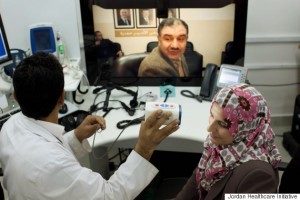This blog was originally published on the Huffington Post ImpactX.
In many parts of the world, being able to download information on a smartphone, tablet or laptop in a few seconds is the norm. In Silicon Valley, wireless high-speed Internet connections are more ubiquitous than Starbucks.
Broadband has changed the way we work, shop, watch movies and communicate with loved ones, allowing us to access more robust types of content, services and applications. Yet if we look beyond our own personal use, we can see that broadband Internet access is not merely a convenience: it is a powerful force for social change.
In education, broadband technology can have a huge impact. Educators face a number of challenges, including teacher shortages, limited access in rural areas and gender disparity. For example, the world would need 3.3 million primary teachers and 5.1 million lower secondary teachers in classrooms by 2030 to provide all children with basic education, according to UNESCO’s 2013-2014 Education For All Global Monitoring Report.
Health care is another field where powerful Internet connections can combat physician shortages and close the urban-rural gap. The World Health Organization reports that more than half of the populations in developing countries live in rural areas, but rural areas are served by less than 25 percent of the total physician workforce.
Here are two examples of how broadband technology is solving global problems and speeding the pace of social change.
Canada’s Nunavut terr itory is the size of Western Europe but has no roads. Its residents connect to each other – and the rest of Canada – only by air travel or, for a few months in summer, by boat. This remoteness creates many challenges in delivering health care as well as education. In September 2013, a satellite broadband connection donated by SSi Micro gave Iqaluit Middle School students a new way to connect to the world – videoconferencing and collaboration technology. Today, Cisco TelePresence connects Nunavut students in real time with teachers, experts, and other students throughout Canada for a more engaging and diverse classroom experience.
itory is the size of Western Europe but has no roads. Its residents connect to each other – and the rest of Canada – only by air travel or, for a few months in summer, by boat. This remoteness creates many challenges in delivering health care as well as education. In September 2013, a satellite broadband connection donated by SSi Micro gave Iqaluit Middle School students a new way to connect to the world – videoconferencing and collaboration technology. Today, Cisco TelePresence connects Nunavut students in real time with teachers, experts, and other students throughout Canada for a more engaging and diverse classroom experience.
The focus of the program is to provide a fresh approach to learning, allowing teachers and administrators to expose their students to new people, experiences and ideas.
The Kingdom of Jordan has a goal to improve access to quality health care for all of its residents, especially those living in rural or underserved areas. Broadband-powered technology is a big part of fulfilling this vision. Through a partnership begun in 2011, Cisco collaboration technologies with high-definition video connect specialists at an urban hospital with patients  at rural hospitals as if they were face-to-face. In 2013, a mobile clinic began providing breast cancer screenings for women in the communities where they live, using Cisco video, networking and security technologies to enable the transfer of images and the collaboration between clinic technicians and specialists at King Hussein Cancer Center.
at rural hospitals as if they were face-to-face. In 2013, a mobile clinic began providing breast cancer screenings for women in the communities where they live, using Cisco video, networking and security technologies to enable the transfer of images and the collaboration between clinic technicians and specialists at King Hussein Cancer Center.
In 2014, the Cisco Service Exchange Platform (SXP) for Radiology – a cloud-based platform that integrates Merge Healthcare picture archiving and communication system (PACS), Optimiza radiology information system (RIS), and Cisco collaboration software – was implemented to provide affordable high-quality radiology services to public hospitals within Jordan. This solution helps improve the quality of care for patients by having images and reports read remotely by the right radiologist for the type of exam. Local doctors in rural hospitals can also collaborate more effectively with radiology specialists located in the capital city, Amman. In just four years, over 110,000 patients have benefited from this initiative.
Every day, broadband is connecting the unconnected. From education to health care to economic opportunity, more people around the word continue to benefit from living in a fully digitized world.
How are you using broadband to solve some of society’s most pressing challenges?


broadband is connecting the unconnected? Really amazing way.
i like this
verry nice
is verry good